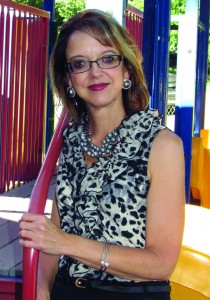 Marty Kemmer-Contreras ’85 believes education is a social justice issue. So much so, this combined political science and history major has spent the last decade trying to level the playing field in early childhood education.
Marty Kemmer-Contreras ’85 believes education is a social justice issue. So much so, this combined political science and history major has spent the last decade trying to level the playing field in early childhood education.
As director of community relations for Colorado Springs’ Community Partnership for Child Development (CPCD), the local grantee for Head Start, Marty champions CPCD’s mission within the community and beyond. When sequestration hit Head Start hard last year, eliminating $530,000 from the budget, she worked on the “Fill a Seat” campaign, during which CPCD sold child-sized chairs from shuttered preschool classrooms, hand-painted by Head Start children, to help raise money. The program was wildly successful and was featured on national television, including MSNBC, “The Rachel Maddow Show,” and “NBC Nightly News.” With the more than $150,000 raised, CPCD was able to open a community classroom that was completely funded by donors and served children who might not otherwise qualify for a place in the classroom.
Based on that success, Marty and others at CPCD decided to use the same community fundraising model to raise money for an Early Head Start classroom at one of their areas of greatest need: Fort Carson, less than 10 miles from Colorado College. An extension of the 2013 “Fill a Seat” project, the ambitious 2014 “Fill a Classroom” initiative sought to raise $75,000 to open an additional preschool program, as the post’s single existing Early Head Start classroom had a waiting list of 35 children, many living below the federal poverty guideline.
The effort was successful, and in October a second Early Head Start classroom opened, allowing eight more children to participate. The cost per child in the Early Head Start classroom, which serves children ages birth to 3, is approximately $10,000, Marty said. In addition to teachers and other trained staff, the cost covers comprehensive skills such as physical check-ups, dental appointments, speech therapy, behavioral assessments, nurses, and family advocates.
“Education is very socio-economically dependent. The upper class has a lot of advantages, and that has repercussions down the road,” she said. “I believe the infrastructure of our country depends on a ready workforce. You put the effort into children when they are young or pay for it later in life. Head Start helps get these children ready before we turn them over to public schools.”
“Combined, the Early Head Start and Head Start programs at Fort Carson provide education and growth experiences for 156 children ages birth to 5, many of whom have a deployed parent,” Marty said. The Head Start program, which serves children ages 3-5, has a wait list of nearly 100 families. Sometimes a family will spend their entire tour at Fort Carson, site of the first Head Start center on any Army post in the country, on the wait list.
“Military families with young children have unique challenges and CPCD can help. They are serving our country and their families deserve a head start,”
Marty said.
Although the Estes Park, Colo., native never set out to advocate for disadvantaged children, her current work follows a trajectory begun at CC. She took time off her junior year to work on Gary Hart’s presidential campaign, serving as his wife’s advisor during the Iowa caucuses and credits the Block Plan for allowing for that flexibility. Jobs since graduation include working for the Colorado Public Interest Research Group (CoPIRG), on a get-out-the-vote initiative for then-Mayor Federico Peña in Denver, the March of Dimes, and as executive director of Keep Colorado Springs Beautiful. She joined CPCD after her three children were in school, or, as she said, “when my own Head Start project was completed.”
Looking back on her CC years, Marty credits professors Doug Monroy, Bill Hochman, and Bob Loevy as being most influential. Her time at CC, she said, taught her to “find my own definition of what it means to be an advocate. I learned you need to add your voice to the debate.” In the end, she said, “I found my niche; I found my talent by adding my voice.” She wants young children to find their niche; to find their talents as well.